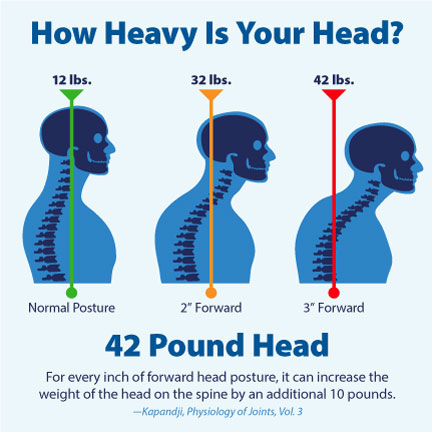Seven C's of Why Neutral Head Posture is "Royally" Important

More and more it seems to be the norm, we find ourselves rushing headlong into the workday, feverishly interfacing with the business world through digital technology as if it were a bicycle race, long until it’s late in the evening. Oftentimes, without considering our body posture or workstation arrangement, we push past the pain with a mercurial temperament, as if the show must go on regardless of the throbbing in our neck and upper body. Though the discomfort may subside when we’re lazing on a Sunday afternoon, quite often it’s just a matter of time for the hammer to fall on developing a cumulative trauma disorder, conceivably of cervical spine origin. With the weight of the human head ranging from 10-12 pounds, here’s some body language on the seven cervical vertebrae in the neck that reinforces the importance of neutral head posture.
(Being the 40th anniversary of Queen recording their “Jazz” album, we’ve hidden 18 Queen song titles in this post, 19 if you include the play on words “Seven C’s of Why” referencing their early hit single “Seven Seas of Rhye”)
C1, the most superior of the cervical vertebrae, is known as the atlas as it’s the first under pressure in supporting the weight of the head (much like mythological Atlas holding up the globe of the world). This vertebra, along with the axis below it, is important neurologically as the brain stem extends down to the level of the axis. C1’s atlanto-occipital joint with the cranium allows the head to nod up and down. This motion is well depicted and exaggerated by Wayne and Garth in Wayne’s World, headbanging to Queen’s Bohemian Rhapsody as the song bursts into its hard rock glory!
C2, the axis, together with the atlas provides left-right rotational head movement. A bony projection called the odontoid process, arising from the body of C2 and stemming upwards to the atlas, is susceptible to fracture. Typically resulting from forceful impact, separation of the process from the axis can possibly lead to nerve and circulation compression conditions.
C3, C4, and C5 form the midsection of the comparatively mobile cervical spine and are in good company with the atlas in also affording some flexion and extension of the head. The phrenic nerve arises from C3, C4, and C5 nerve roots and innervates the diaphragm, an essential muscle for breathing. (Irritation of the phrenic nerve is a common cause of hiccups)
C6 and C7 complete the cervical spine, with the spinal nerves emanating between these vertebrae contributing to the brachial plexus of nerves which provides almost all the innervation to the upper limb. Play the game Trivial Pursuit and you might stumble on the question of which cervical vertebra has a distinctive long and prominent spinous process that can be palpated, or felt, at the base of the neck. The answer is C7, otherwise known as the vertebra prominens.
And there you have it, without innuendo - the seven C’s of the cervical spine that withstand even greater force when the head is projected forward as seen in this illustration.

With that, here are some MEMIC Safety Net posts that you might find helpful to keep yourself alive and vibrant with good posture.
Let Posture Be Your Guide discusses the unconscious behavior aspect of awkward posture.
Ergonomics and Mobile Workers offers tips for laptop, tablet, and smartphone use.
Heads-up! “Text Neck” on the Rise includes a link to the Text Neck Institute’s website which discusses the consequences of forward head posture.
Back to Routine Doesn’t Mean Back to Pain reviews proper posture for computer users and emphasizes the importance of taking micro-breaks regularly.
MEMIC policyholders, we will rock you with our online safety resources that some might say are “magnifico-o-o-o-o!” Log into the Safety Director and start or update your safety survey to see if you’re doing all right with your safety program and where you might be able to make improvements. It only takes a flick of the wrist with a mouse click to get started. And may you nevermore endure pain from awkward head posture!
(You may be saying, “You don’t fool me, there’s only 17!” Here are the 18 Queen songs in this post: headlong, bicycle race, it’s late, the show must go on, lazing on a Sunday afternoon, hammer to fall, body language, under pressure, Bohemian Rhapsody, good company, Play the game, innuendo, keep yourself alive, we will rock you, doing all right, flick of the wrist, nevermore, You don’t fool me.)
By Greg LaRochelle

